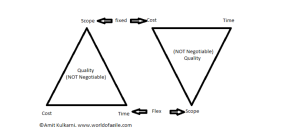Agile Project Management
The essence of the difference between traditional project management and Agile project management lies in how you look at the three primary constraints of project management
- Scope
- Cost
- Time
Flex Scope and Fixed Cost/Time
In a traditional project management approach, the fixed part is the Scope and the other factors such as Time and Cost is changed (of course by raising change requests) as per the changes in Scope.
Agile Project Management fixes cost, quality and time at the outset and uses the MOSCOW prioritization of scope into musts, shoulds, coulds and won’t haves to adjust the project deliverable to meet the stated time constraint. The non-negotiable part is the Time and Cost. That is, you need to deliver features in a fixed time and at a fixed cost. What to deliver can be adjusted as per prioritization and as per the estimates in a given time and given cost.

Agile Project Management looks at cost, scope and time differently. In Agile, Cost and time are considered fixed and the scope is considered variable.
Guidance for Traditional and Agile Project Management
Standard guidance for traditional project management is provided in the PMI’s PMBoK manual. The PMBoK 6 version introduced a Agile Practice guide which gives a fair guidance on what Agile Project Management really is. Other than the PMBoK manual, there are various other literature on Scrum which is an successful Agile Project Management framework. Infact, 70-80% of the projects in IT are done using Scrum framework. It is worthwhile reading through the scrum guide on www.scrumguides.org and also read various literatures on Scrum written by various famous authors such as Mike Cohn, Jeff Sutherland and Ken Schwaber.